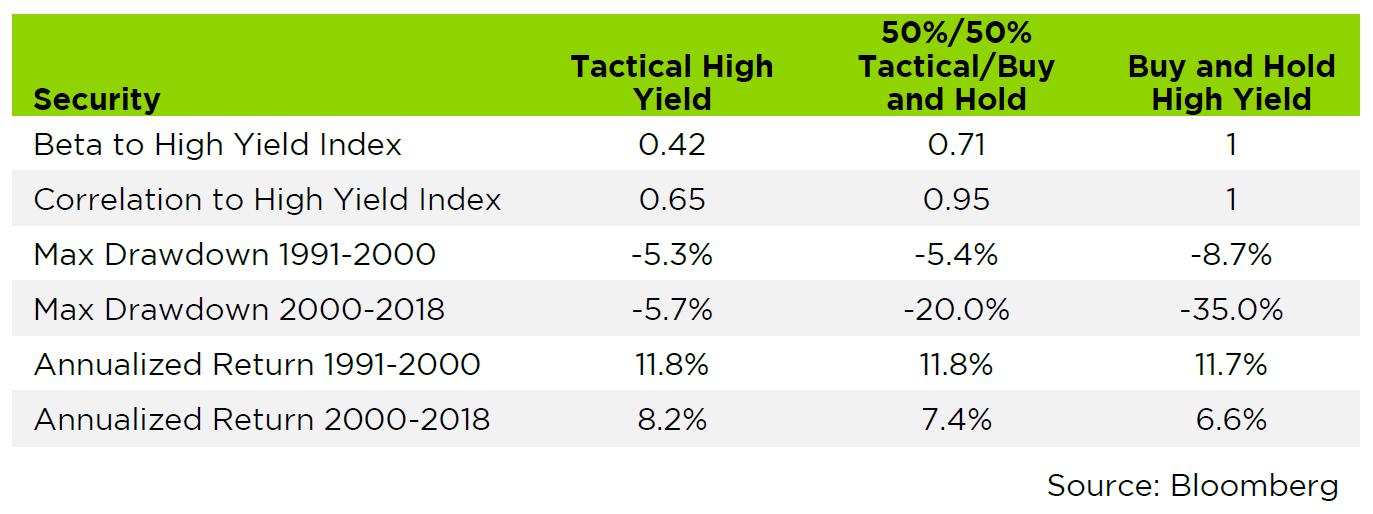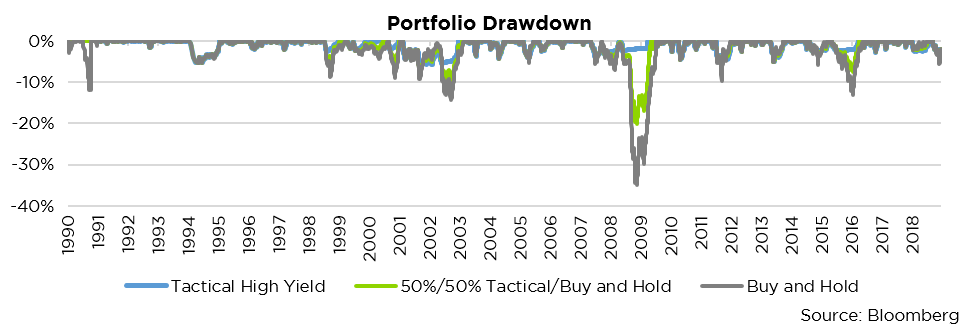Markets delivered a rough close to 2018. Risky asset prices whipsawed, and a bear market in U.S. equities may have taken hold. Investors who had looked to high yield credit for income and relative stability have been rewarded with a roughly 7% price decline in 2018. When year-end statements arrive, advisors who’ve heavily allocated to high yield and stocks may find themselves fielding some strongly worded client questions.
The emotional responses that harm client-advisor relationships may not have a cure, but we think there’s a vaccine. We previously analyzed the benefits to equity investors of a blended approach between buy-and-hold and tactical asset allocation (also known as trend-following or time series momentum). Amid the recent tumult, we thought we’d apply the same framework to high yield. We found that the benefits of a blended strategy are similar in both asset classes.
Rising Markets
In steadily rising markets, buy-and-hold tends to slightly outperform tactical asset allocation, as tactical models are subject to false risk-off signals that drag on returns. So why not allocate to both over the long haul? It might help the client relationship. During rising markets, advisors who allocate to a 50-50 blended strategy can show clients that the buy-and-hold allocation is keeping pace with the market, and position any underperformance of the tactical component as a modest sacrifice in the name of conservatism. As we’ll see, that conservatism may pay off when times are not so good.
The “Tactical High Yield” strategy is defined here as owning the ICE BofAML US High Yield index when it is above its 200-day average, and owning 90-day T-bills when the same high yield index is below its 200-day moving average. The following table illustrates the historical performance since 1991 for pure tactical allocation, a 50-50 blend, and pure buy-and-hold — all applied to high yield.

On examination, the 50-50 blend has some advantages. Its beta to the high yield index, a measure of how well its risk and return profile is explained by the broad market, is reduced compared with pure buy-and-hold.
Portfolio Drawdown

Meanwhile as pictured above, the 50-50 approach has a major advantage over buy-and-hold when it comes to drawdowns. Not surprisingly, the 50-50 blend approach inherits tactical’s key trait of targeted reduction of drawdowns.
Falling Markets
The tactical component of a blended asset allocation model shows its true value when markets decline. While the buy-and-hold component is fully exposed to drawdowns, a tactical strategy is designed to go “risk-off” as assets enter a downtrend. Going “risk-off” involves selling out of the high yield index position and investing instead in cash or Treasury bonds. In smoothly down-trending markets, the tactical component of the portfolio potentially outperforms, and it does so at the most important behavioral moment for investors – the stressful moment when wealth seems to disappear.
As markets fall, an advisor with a blended allocation to tactical and buy-and-hold strategies can point to overall outperformance of the client’s risky asset portfolio, and remind the client of the tactical component’s presence as it enters a risk-off posture (where it sells out of high yield).
Both Strategies Have Merit
It’s a simple but important point: Buy-and-hold and tactical strategies both offer benefits to investors. Crucially, it’s difficult if not impossible to guess in advance which strategy will do better in the near term.
Buy and Hold Rolling 12-Month Outperformance vs 200-Day Moving Average Strategy

As displayed above, trend-following handily beat buy-and-hold for the bulk of the sample, with the most substantial exception being the post-financial crisis recovery period, around 2009. One-year returns can also be noisy, and a look at 3 year relative performance shows similar favorable long-term picture in favor of using tactical strategies, though again the results vary.
Buy and Hold Rolling 36-Month Outperformance vs 200-Day Moving Average Strategy

Quant or By Feel?
We would guess that relying on intuition amid the market’s recent gyrations would have generated more nausea than outperformance in the past year. That’s where we see the benefit of quantitative strategies. They have the virtue of execution discipline and statistical validation – they play by predetermined rules, and the results are measurable across market environments. All of this makes it easier to stick with the system, especially in times of doubt.
As the cliche goes, no one has a crystal ball. Without foreknowledge of which strategy might perform better in the future, an advisor should consider simply splitting the difference by using a blended allocation to quantitative trend-following and buy-and-hold.
We’re unaware of any investment strategy that can completely neutralize risk or drawdowns, or any strategy that makes the advisor-client relationship totally easy. But we do believe that advisors should look for strategies that have strong safeguards against the most challenging market conditions, as well as their clients’ most challenging behavioral tendencies. A 50-50 blend of tactical asset allocation with buy-and-hold appears to deliver just such an advantage, whether applied to stocks or to high yield.